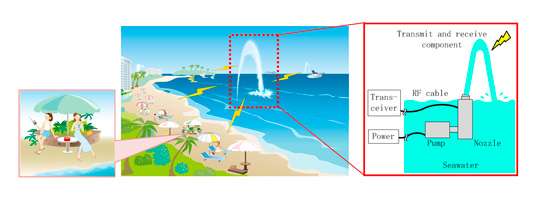Mitsubishi Electric, in the business of selling electrical and electronic equipment used in industries ranging from satellite communications, to energy and building equipment, is interested in coming up with innovative ways to building antennas and exploring new materials for antennas.
Making news earlier this week is their announcement of a seawater antenna which they are calling SeaAerial. As the name suggests, at play here is a liquid—seawater, the most abundant resource on Earth.
David Szondy in Gizmag commented: "When someone mentions a radio aerial, it tends to conjure up a vision of something made of steel and wire. But what about one made of water?"
Mitsubishi asked the same question. The company's news release said this seawater antenna is capable of receiving digital terrestrial broadcasts for normal viewing. The interesting advantage about this concept is its indication that you can create a large antenna without having to perform massive construction.
How innovative is this development?
Szondy said, "This isn't the first seawater antenna – the US Navy has taken a keen interest in the idea in recent years."
Mitsubishi's SeaAerial can be used for offshore or along shorelines.
How it works: It shoots a column of seawater into the air creating a conductive plume for the transmission and reception of radio-frequency waves. An insulated nozzle transmits radio waves to the antenna even when the plume is physically connected to the sea surface. The insulation is achieved with a quarter-wavelength tube in the nozzle.
Problem: seawater is much less conductive than metal. For efficiency (ratio of radiated power to input power) Mitsubishi Electric used simulations to determine the plume's ideal diameter. Result: an efficiency level of 70 percent, enough to transmit and receive signals.
Antenna size is another issue that turned out not to be a drawback for Mitsubishi Electric. Szondy wrote about the size challenge:
"In our day to day lives, we're used to dealing with radio frequencies that are so short and relatively strong that the transceiver antennae on our devices are correspondingly tiny. However, as radio frequencies get longer and the signals become weaker, the antenna has to be longer as well. This fact of life means that many radio installations require very large antennae that are expensive, time consuming to build, and far from portable," said Szondy.
With SeaAerial, moving can be done easily by ship and other vessels. Its design is such that it just needs a pump and insulated nozzle.
Meanwhile, there is indication that SSC Pacific, a U.S. Navy research and development laboratory for command, control, communications, computers, intelligence, surveillance, and reconnaissance, have worked on a Sea Water Antenna System in the past.
SSC Pacific's website explained their work: They developed "a technology that uses the magnetic induction properties of sodium chloride (salt) in seawater to transmit and receive communication signals. The device works by pumping a stream of seawater through a current probe. The height of the seawater stream determines the antenna's frequency. For example, UHF frequencies require a 2-foot high stream of water, while VHF and HF frequencies require 6-foot and 80-foot high streams (respectively). The width of the stream determines the antenna's bandwidth. The antenna requires a relatively small footprint and can be modified to accommodate multiple frequencies and bandwidths by stacking current probes and adding additional spray nozzles."
The SSC Pacific site also said this technology could be used even on land with salt-supplemented water, "replacing large unsightly antenna towers with fountains. The device could also be used on land or sea as a solar- or battery-powered emergency antenna system."
More information: www.mitsubishielectric.com/news/2016/0127.html
© 2016 Tech Xplore
























